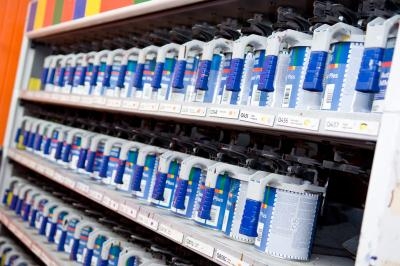
Knowing which types of paint to apply through an automotive spray gun can make the difference in producing a perfect finished topcoat or having to repaint. There are several different spray guns that are used in the vehicle refinishing industry, and their designs usually make them ideal for one particular type of paint application. By understanding the different paint materials used on different types of cars, the home auto enthusiast will be able to produce work that even the professionals would be proud of.
Cellulose paints are rarely used on modern vehicles but suppliers still carry stock for restoration projects and repairs to older models. Cellulose paint is solvent-based and can be applied through traditional gravity or suction-fed spray guns. Once applied, the solvents in the paint evaporate to leave a durable gloss finish. Colors can fade over time because of weather exposure, and gloss retention levels are poor. However, most cellulose products can be easily restored with an abrasive cutting compound.
Two-pack paint materials are still used on factory-produced models but tend to be applied to small commercial vehicles, such as vans, when used in solid color form. Two-pack colors are usually acrylic-based, although some manufacturers continue to use an older urethane alternative. The material can be sprayed through suction-fed spray guns, and an excellent finish can be achieved with a DeVilbiss JGA model. Topcoats are hard, high in gloss and very resistant to stone chips. Most colors are able to withstand heat and damp weather conditions without fading but pigmentation issues in red shades can sometimes cause bleaching or oxidization.
Synthetic paints are widely used on heavy commercial units, such as trucks and lorries. Large vehicles are often difficult to park in spray booths, so synthetic materials are used because of their ability to air dry. Although application can be made with a brush or roller, the best finishes can be achieved when the material is sprayed through a spray gun with a large fluid tip setup attached to a pressure pot. Synthetic paints can take several weeks to cure completely and rectification work on blemishes is not advisable during this period,.
Water-based colors are applied to new vehicles to provide color, but they offer very little protection to the surface of the panel. Water-based materials are widely used in body shops because of the low levels of volatile organic compounds they produce. They should be applied with a high-volume, low-pressure spray gun with a 1.2 mm fluid tip setup and activated with a compatible agent before use.
Modern clear coats are applied over water-based colors to provide gloss and protection. These products are actually two-pack materials as well but are sprayed differently because of their high solid content. Application requires an HVLP spray gun with a 1.4 mm fluid tip setup so a wider fan can be achieved. This promotes full panel coverage and even product distribution.